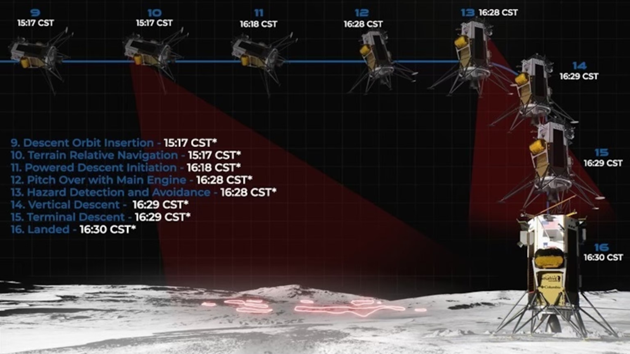(HOUSTON) — A Houston-based company is attempting to make the first-ever commercial moon landing on Thursday, and the first by a U.S.-built spacecraft in more than 50 years.
Intuitive Machines’ lander, named Odysseus, launched last week from NASA’s Kennedy Space Center in Florida and entered lunar orbit on Wednesday.
It will orbit the moon for about one day before beginning its descent and will attempt to soft-land near the south pole at 6:24 p.m. ET, according to NASA. However, video of the landing will be delayed reaching Earth by at least 45 minutes.
The lander is carrying five NASA instruments, including a radio beacon meant to transmit precise geolocation and cameras that capture how the surface of the moon changes from interactions with the engine plume of the spacecraft, as well as commercial cargo.
If the landing is successful, Odysseus — nicknamed “Odie” by employees — will have seven days before darkness descends on the landing site, which will prevent the spacecraft’s solar panels from gathering energy from sunlight and bringing freezing temperatures.
Intuitive Machines was one of several companies approved by NASA under Commercial Lunar Payload Services (CLPS) contracts to build private lunar landers that the federal space agency, among others, would use to send instruments into space.
Steve Altemus, president and CEO of Intuitive Machines, said the company’s employees’ names are engraved into the footer to permanently stamp their names on the lunar surface.
“I had everyone’s name etched on the bottom of the landing gear so that their names will be indelibly printed on the moon when we touch down softly,” he told ABC News.
This is the third attempt to land on the moon this year. In early January, the Peregrine lunar lander, built by Astrobotic, developed a critical fuel leak, forcing it to return to Earth and burn upon re-entry.
Meanwhile, Japan launched a rocket to the moon in September 2023 and landed on Jan. 19, becoming the fifth country to do so. However, the lunar lander landed upside down and could not deploy its solar arrays.
“There’s reduced gravity There’s very little atmosphere, lot of dust, and so the engineers have to speculate how a spacecraft would behave in that type of environment, right? And it doesn’t exist here on Earth,” Regina Blue, NASA’s CLPS deputy program manager, told ABC News, explaining why it’s so difficult to land on the moon.
“So they have to spend lots of hours testing and testing and doing more testing and even that, getting into that environment there is a good amount of unpredictability, so that makes it very, very hard,” she continued.
These robotic missions are important to explore the moon as NASA and the Canadian Space Agency prepare to send four astronauts to fly around the moon in the upcoming Artemis II mission next year. If the mission is successful, Artemis III — a moon landing — is scheduled for 2026.
The Artemis team will be made up of three Americans — Victor Glover, Christina Hammock Koch, and Reid Wiseman — and one Canadian, Jeremy Hansen.
Copyright © 2024, ABC Audio. All rights reserved.












